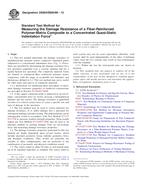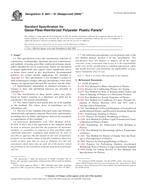Wir benötigen Ihre Einwilligung zur Verwendung der einzelnen Daten, damit Sie unter anderem Informationen zu Ihren Interessen einsehen können. Klicken Sie auf "OK", um Ihre Zustimmung zu erteilen.
ASTM D6264/D6264M-12
Standard Test Method for Measuring the Damage Resistance of a Fiber-Reinforced Polymer-Matrix Composite to a Concentrated Quasi-Static Indentation Force
Automatische name übersetzung:
Standardtestverfahren zur Messung der Beschädigungsfestigkeit eines faserverstärkten Polymermatrix-Verbundmaterial, um eine konzentrierte Quasistatisches Eindruckkraft
NORM herausgegeben am 1.4.2012
Informationen über die Norm:
Bezeichnung normen: ASTM D6264/D6264M-12
Anmerkung: UNGÜLTIG
Ausgabedatum normen: 1.4.2012
SKU: NS-34446
Zahl der Seiten: 11
Gewicht ca.: 33 g (0.07 Pfund)
Land: Amerikanische technische Norm
Kategorie: Technische Normen ASTM
Kategorie - ähnliche Normen:
Die Annotation des Normtextes ASTM D6264/D6264M-12 :
Keywords:
composite materials, damage resistance, delamination, dent, impact, quasi-static indentation, Composites, Damage assessment, Fiber-reinforced composites, Polymer matrix composite materials, ICS Number Code 83.120 (Reinforced plastics)
Ergänzende Informationen
| Significance and Use | ||||||||||||||||||||||||||||||||||||||
|
Susceptibility to damage from concentrated out-of-plane forces is one of the major design concerns of many structures made of advanced composite laminates. Knowledge of the damage resistance properties of a laminated composite plate is useful for product development and material selection. QSI testing can serve the following purposes: To simulate the force-displacement relationships of impacts governed by boundary conditions (1-7). These are typically relatively large-mass low-velocity hard-body impacts on plates with a relatively small unsupported region. Since the test is run slowly in displacement control, the desired damage state can be obtained in a controlled manner. Associating specific damage events with a force during a drop-weight impact test is often difficult due to the oscillations in the force history. In addition, a specific sequence of damage events may be identified during quasi-static loading while the final damage state is only identifiable after a drop-weight impact test. To provide an estimate of the impact energy required to obtain a similar damage state for drop-weight impact testing if all others parameters are held constant. To establish quantitatively the effects of stacking sequence, fiber surface treatment, variations in fiber volume fraction, and processing and environmental variables on the damage resistance of a particular composite laminate to a concentrated indentation force. To compare quantitatively the relative values of the damage resistance parameters for composite materials with different constituents. The damage response parameters can include dent depth, damage dimensions and through-thickness locations, Fmax, Ea, and Emax, as well as the force versus indenter displacement curve. To impart damage in a specimen for subsequent damage tolerance tests, such as Test Method D7137/D7137M. To measure the indentation response of the specimen with and without bending using the two specimen configurations (edge supported and rigidly backed). The properties obtained using this test method can provide guidance in regard to the anticipated damage resistance capability of composite structures of similar material, thickness, stacking sequence, etc. However, it must be understood that the damage resistance of a composite structure is highly dependent upon several factors including geometry, thickness, stiffness, mass, support conditions, etc. Significant differences in the relationships between force/energy and the resultant damage state can result due to differences in these parameters. For example, properties obtained using the specimen supported over a circular hole would more likely reflect the damage resistance characteristics of an un-stiffened monolithic skin or web than that of a skin attached to sub-structure which resists out-of-plane deformation. Similarly, test specimen properties would be expected to be similar to those of a panel with equivalent length and width dimensions, in comparison to those of a panel significantly larger than the test specimen, which tends to divert a greater proportion of the energy into elastic deformation. The standard indenter geometry has a blunt, hemispherical tip. Historically, for the standard laminate configuration, this indenter geometry has generated a larger amount of internal damage for a given amount of external damage than is typically observed for similar indenters using sharp tips. Alternative indenter geometries may be appropriate depending upon the damage resistance characteristics being examined. For example, the use of sharp tip geometries may be appropriate for certain damage visibility and penetration resistance assessments. Some testing organizations may desire to use this test method in conjunction with Test Method D7137/D7137M to assess the compression residual strength of specimens containing a specific damage state, such as a defined dent depth, damage geometry, etc. In this case, the testing organization should subject several specimens to multiple energy or force levels using this test method. A relationship between energy or force and the desired damage parameter can then be developed. Subsequent QSI and compression residual strength tests can then be performed using specimens indented at an interpolated energy or force level that is expected to produce the desired damage state. |
||||||||||||||||||||||||||||||||||||||
| 1. Scope | ||||||||||||||||||||||||||||||||||||||
|
1.1 This test method determines the damage resistance of multidirectional polymer matrix composite laminated plates subjected to a concentrated indentation force (Fig. 1). Procedures are specified for determining the damage resistance for a test specimen supported over a circular opening and for a rigidly-backed test specimen. The composite material forms are limited to continuous-fiber reinforced polymer matrix composites, with the range of acceptable test laminates and thicknesses defined in 8.2. This test method may prove useful for other types and classes of composite materials. 1.1.1 Instructions for modifying these procedures to determine damage resistance properties of sandwich constructions are provided in Practice D7766/D7766M. 1.2 A flat, square composite plate is subjected to an out-of-plane, concentrated force by slowly pressing a hemispherical indenter into the surface. The damage resistance is quantified in terms of a critical contact force to cause a specific size and type of damage in the specimen. 1.3 The test method may be used to screen materials for damage resistance, or to inflict damage into a specimen for subsequent damage tolerance testing. The indented plate can be subsequently tested in accordance with Test Method D7137/D7137M to measure residual strength properties. Drop-weight impact per Test Method D7136/D7136M may be used as an alternate method of creating damage from an out-of-plane force and measuring damage resistance properties. 1.4 The damage resistance properties generated by this test method are highly dependent upon several factors, which include specimen geometry, layup, indenter geometry, force, and boundary conditions. Thus, results are generally not scalable to other configurations, and are particular to the combination of geometric and physical conditions tested. 1.5 The values stated in either SI units or inch-pound units are to be regarded separately as standard. The values stated in each system may not be exact equivalents; therefore, each system shall be used independently of the other. Combining values from the two systems may result in non-conformance with the standard. 1.5.1 Within the text the inch-pound units are shown in brackets. 1.6 This standard does not purport to address all of the safety concerns, if any, associated with its use. It is the responsibility of the user of this standard to establish appropriate safety and health practices and determine the applicability of regulatory limitations prior to use.
|
||||||||||||||||||||||||||||||||||||||
| 2. Referenced Documents | ||||||||||||||||||||||||||||||||||||||
|
Ähnliche Normen:
Historisch
1.11.2010
Historisch
1.10.2011
Historisch
1.5.2012
Historisch
1.12.2012
Historisch
1.9.2009
Historisch
1.3.2008
Empfehlungen:
Aktualisierung der technischen Normen
Wollen Sie sich sicher sein, dass Sie nur die gültigen technischen Normen verwenden?
Wir bieten Ihnen eine Lösung, die Ihnen eine Monatsübersicht über die Aktualität der von Ihnen angewandten Normen sicher stellt.
Brauchen Sie mehr Informationen? Sehen Sie sich diese Seite an.



 ASTM D3529M-10
ASTM D3529M-10 ASTM D3531/D3531M-11..
ASTM D3531/D3531M-11.. ASTM D3532/D3532M-12..
ASTM D3532/D3532M-12.. ASTM D3552-12
ASTM D3552-12 ASTM D3647-09
ASTM D3647-09 ASTM D3841-97(2008)e..
ASTM D3841-97(2008)e..
 Cookies
Cookies
